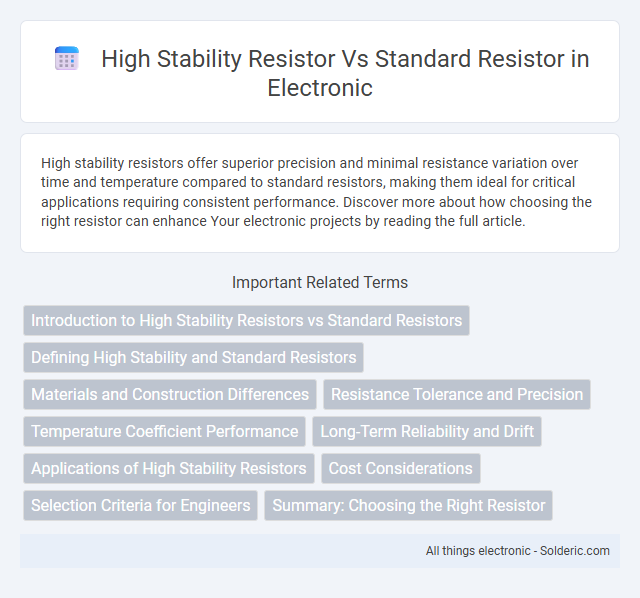High stability resistors offer superior precision and minimal resistance variation over time and temperature compared to standard resistors, making them ideal for critical applications requiring consistent performance. Discover more about how choosing the right resistor can enhance Your electronic projects by reading the full article.
Comparison Table
| Feature | High Stability Resistor | Standard Resistor |
|---|---|---|
| Resistance Tolerance | +-0.01% to +-0.1% | +-1% to +-5% |
| Temperature Coefficient (TCR) | <= +-10 ppm/degC | +-50 to +-200 ppm/degC |
| Long-Term Stability | Excellent; minimal drift over time | Moderate; noticeable drift over extended use |
| Power Rating | Typically 0.25W to 1W | Typically 0.125W to 0.5W |
| Noise Level | Low noise; ideal for precision circuits | Higher noise; suitable for general use |
| Applications | Precision measurement, calibration, instrumentation | General purpose, consumer electronics |
| Cost | Higher price due to enhanced performance | Lower cost, mass-produced |
Introduction to High Stability Resistors vs Standard Resistors
High stability resistors maintain precise resistance values under varying environmental conditions, offering enhanced temperature coefficients and long-term reliability compared to standard resistors. These resistors typically utilize advanced materials and manufacturing techniques, resulting in superior performance for critical applications such as precision measurement, aerospace, and medical equipment. Standard resistors meet general circuit requirements but lack the enhanced tolerance and stability required where accuracy over time and temperature is crucial.
Defining High Stability and Standard Resistors
High stability resistors maintain precise resistance values over wide temperature ranges and extended periods, offering minimal drift and low tolerance levels typically below 0.1%. Standard resistors exhibit higher tolerance, often around 5%, with greater susceptibility to environmental factors such as temperature fluctuations and humidity. Choosing a high stability resistor ensures Your circuit's performance remains consistent in critical applications requiring exact resistance parameters.
Materials and Construction Differences
High stability resistors are typically made using metal foil or metal film materials that provide superior temperature coefficient and long-term stability compared to the carbon film or metal oxide materials commonly found in standard resistors. The construction of high stability resistors often involves precise trimming and encapsulation techniques that minimize mechanical stress and environmental influences, ensuring consistent resistance values over time. Your choice of a high stability resistor guarantees enhanced performance in precision applications where minimal drift and reliability are critical.
Resistance Tolerance and Precision
High stability resistors offer superior resistance tolerance, typically within +-0.1% or better, compared to standard resistors, which often range from +-1% to +-5%. This enhanced precision ensures minimal resistance variation over temperature changes and long-term use, making them ideal for sensitive electronic applications. The improved materials and manufacturing processes in high stability resistors contribute significantly to maintaining consistent electrical performance.
Temperature Coefficient Performance
High stability resistors exhibit significantly lower temperature coefficient values, often less than 10 ppm/degC, compared to standard resistors which typically range from 50 to 200 ppm/degC. This superior temperature coefficient performance ensures minimal resistance change over varying temperatures, providing enhanced accuracy and reliability in precision circuits. Your applications requiring consistent resistance under fluctuating thermal conditions benefit greatly from high stability resistor selection.
Long-Term Reliability and Drift
High stability resistors exhibit superior long-term reliability compared to standard resistors by maintaining resistance values within tighter tolerance ranges over extended periods. Their drift rates typically measure in parts per million per year (ppm/year), significantly lower than the several percent drift often seen in standard resistors. This low drift performance is crucial for precision applications requiring consistent electrical characteristics throughout the component's lifespan.
Applications of High Stability Resistors
High stability resistors are essential in precision measurement instruments, aerospace systems, and medical equipment where consistent resistance values ensure accurate performance over time and varying environmental conditions. These resistors maintain their electrical characteristics despite temperature fluctuations, mechanical stress, and aging, making them ideal for calibration and sensor applications. Standard resistors, by contrast, may exhibit drift and are less suitable for critical systems that demand long-term reliability and minimal tolerance variation.
Cost Considerations
High stability resistors typically come at a higher cost than standard resistors due to their precise materials and manufacturing processes designed to maintain resistance under varying environmental conditions. While standard resistors may suffice for general applications with less stringent requirements, choosing a high stability resistor ensures long-term reliability, which can reduce maintenance costs and downtime in critical systems. Evaluating Your application's sensitivity to resistance changes will guide the cost-benefit analysis between these resistor types.
Selection Criteria for Engineers
Engineers select high stability resistors over standard resistors when precision and long-term reliability are critical, such as in aerospace, medical devices, and instrumentation. High stability resistors offer low temperature coefficients, reduced drift, and superior tolerance, ensuring consistent performance under varying environmental conditions. Key factors include the application's tolerance requirements, thermal stability, frequency response, and cost-effectiveness in high-precision circuits.
Summary: Choosing the Right Resistor
High stability resistors offer superior precision and minimal resistance drift over time and temperature variations compared to standard resistors, making them ideal for critical applications in medical devices, aerospace, and precision instrumentation. Standard resistors are suitable for general-purpose circuits where tolerance and stability requirements are less stringent, providing cost-effective solutions for everyday electronic designs. Selecting the right resistor depends on factors like required accuracy, environmental conditions, and long-term reliability to ensure optimal circuit performance.
high stability resistor vs standard resistor Infographic

 solderic.com
solderic.com